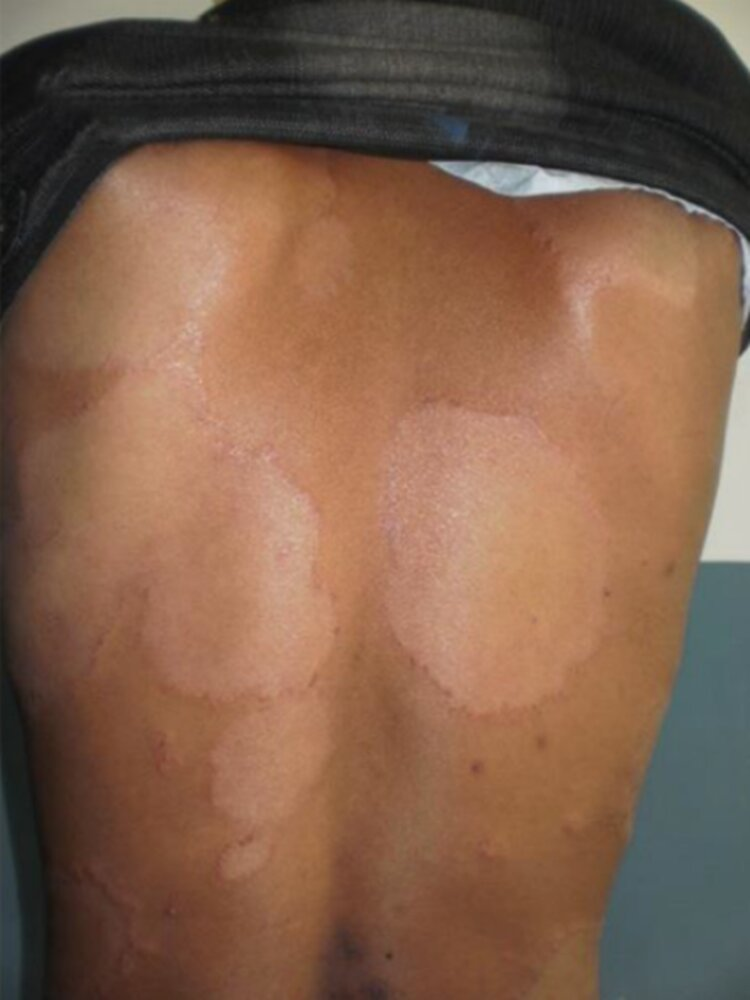Epidemiology
Etiology
- Pathogen: Mycobacterium leprae is an obligate, intracellular, acid-fast bacillus that cannot be cultured and thrives in cold temperatures.
- Route of transmission
- Close contact with fomites, contaminated soil, infected individuals, and nine-banded armadillos (in rare cases)
- Respiratory droplet transmission
- Risk factors are close contact with infected individuals or contaminated soil.
Pathophysiology
- The range of clinical manifestations depends on the strength of the cell-mediated immune (CMI) response.
- Tuberculoid leprosy (TT) is the least severe form and is often self-limited. Mycobacterial infection is limited by an intact CMI response (Th1-mediated). Mild skin plaques develop and are associated with hypopigmentation, hair follicle loss, and focally decreased sensation.
- Nerve demyelination is the result of a T-cell mediated response.
- T cells cross the perineurium and destroy Schwann cells and axons. The epineurium is fibrotic and the endoneurium is replaced by granulomas.
- Nerve demyelination is the result of a T-cell mediated response.
- Lepromatous leprosy (LL), the most severe form, occurs in patients with a weak CMI response (Th2-mediated). Macrophage signaling to kill M leprae is limited, leading to mycobacterial dissemination. Manifestations include diffuse skin thickening, plaque-like hypopigmentation (often with hair loss), leonine facies, paresis, regional anesthesia, testicular destruction, and blindness.
- Nerve lesions are the result of M. leprae invasion.
- M. leprae thrives at cool areas on the body (skin, mucous membranes, peripheral nerves, anterior chamber of the eye, upper respiratory tract, testes).
Clinical features
Both: Nerve involvement leads to nerve enlargement and peripheral nerve palsies which present with sensory, motor, and/or autonomic deficits.
Tuberculoid leprosy (TT)
- Cutaneous manifestations
- Few (usually 1–3 lesions), localized, hypopigmented macules, plaques, and/or papules with well-defined, erythematous, and/or raised margins

- Lesions are dry, scaly, anhidrotic.
- Hair loss
- Hyperesthesia of the skin lesion is common and occurs early (hypoaesthesia of the skin develops in later stages).
- Few (usually 1–3 lesions), localized, hypopigmented macules, plaques, and/or papules with well-defined, erythematous, and/or raised margins
- Nerve Involvement
- Occurs early but is localized.
- Asymmetric enlargement of one or many peripheral nerves.
- Acute neuritis does not occur.
Lepromatous leprosy (LL)
- Cutaneous manifestations
- Multiple symmetrical macules, plaques, and/or nodules
- Generalized involvement of the skin
- Nodules on the face may coalesce → leonine facies
- Nodules may ulcerate
- Hypesthesia of the skin lesion is less common and occurs only in the late stages of the disease.
- Supraciliary and ciliary madarosis
- Multiple symmetrical macules, plaques, and/or nodules
- Nerve Involvement
- Occurs late, but is more extensive.
- Acral, distal, symmetrical anesthesia.
- Usually begins with stocking glove pattern that spreads proximally.
- Nerve involvement leads to nerve enlargement and peripheral nerve palsies which present with sensory, motor, and/or autonomic deficits.
- Ulnar nerve palsy: clawing of the fourth and fifth fingers, wasting of dorsal interosseous nerves, loss of sensation
- Peroneal nerve palsy: foot drop
- Posterior auricular nerve
- Posterior tibial nerve
Diagnostics
The lepromin skin test (in which M leprae antigens are injected intradermally) can be used to distinguish between tuberculoid and lepromatous leprosy. Patients with tuberculoid leprosy will develop an indurated nodule at the site of the injection (much like a positive PPD test for M tuberculosis). In contrast, the test is usually nonreactive in patients with lepromatous leprosy due to their weak TH1 cell-mediated immune response.
Treatment
Dapsone
- Mechanism of action
- Competitive antagonist of para-aminobenzoic acid (PABA) for dihydropteroate synthetase → inhibition of dihydrofolic acid synthesis
- Structurally different from sulfonamides but a similar mechanism of action
- Clinical use
- M. leprae: lepromatous and tuberculoid leprosy
- P. jiroveci pneumonia
- Prophylaxis
- Treatment: used in combination with TMP as an alternative to TMP/SMX
- Adverse effects
- Methemoglobinemia
- Triggers hemolytic anemia in patients with G6PD deficiency
- Agranulocytosis